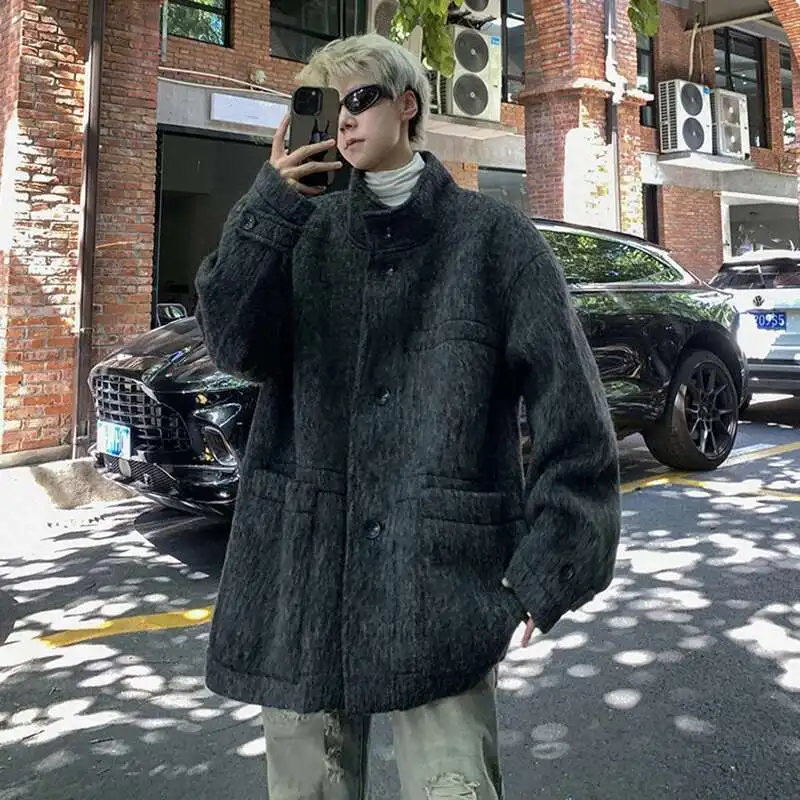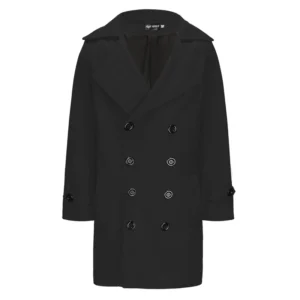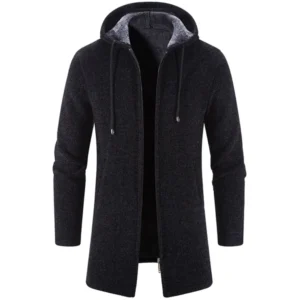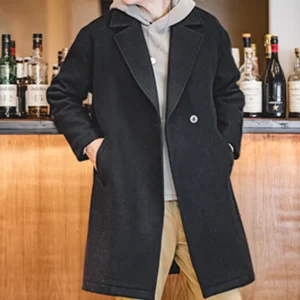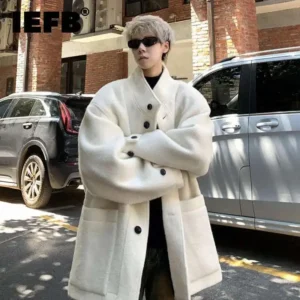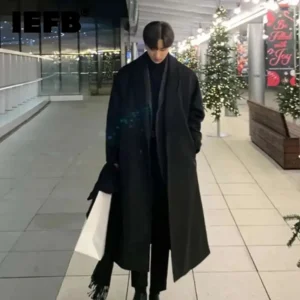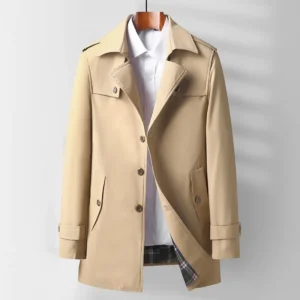Why a Cashmere Overcoat is the Ultimate Winter Investment
When it comes to premium winter outerwear, nothing quite compares to a well-crafted cashmere overcoat. These exceptional garments offer an unmatched combination of luxurious softness and remarkable warmth without the bulk of other materials. What truly sets cashmere apart is its outstanding warmth-to-weight ratio – providing incredible insulation while remaining surprisingly lightweight. This natural temperature regulation keeps you perfectly comfortable whether entering a heated building or braving cold winds.
Beyond its practical benefits, a quality cashmere overcoat represents timeless elegance that transcends seasonal fashion trends. For centuries, cashmere has been treasured by royalty and discerning individuals who recognize its superior qualities. When you invest in a premium cashmere coat, you’re not simply buying winter protection – you’re acquiring a garment that can serve you beautifully for decades with proper care.
This comprehensive guide will walk you through everything you need to know about making this significant investment. We’ll explore how to assess cashmere quality, find your perfect fit, select enduring styles, recognize superior construction, and maintain your garment for years of enjoyable wear. Whether you’re purchasing your first luxury overcoat or adding to a refined collection, this guide is designed to help the discerning gentleman make a confident, informed decision.
The journey to finding your ideal cashmere overcoat begins with understanding what truly makes this material special and why it’s worth the investment. Let’s explore the world of premium cashmere and discover how to select a coat that will bring you satisfaction for years to come from Metro Cloak’s men’s cashmere overcoat collection.
Understanding Cashmere Quality: The Foundation of Your Purchase Decision
Decoding Cashmere Grades and Quality Indicators
Not all cashmere is created equal, and understanding the grading system is essential for making an informed purchase. Cashmere is typically categorized into three grades:
- Grade A: The highest quality, featuring fibers under 16 microns in diameter and at least 36mm in length, resulting in exceptional softness and durability
- Grade B: Mid-range quality with fibers between 16-19 microns and 28-34mm length
- Grade C: Lower quality with coarser fibers above 19 microns and shorter lengths, more prone to pilling
Fiber length significantly impacts your overcoat’s longevity and resistance to pilling. Longer fibers can be spun into stronger yarn that maintains its integrity through years of wear. Meanwhile, fiber diameter (measured in microns) determines softness – the lower the micron count, the softer the feel against your skin.
Equally important is ply count, which refers to how many strands of yarn are twisted together. Single-ply cashmere is lighter but less durable, while two-ply offers an excellent balance of softness and strength. Premium overcoats often feature two-ply construction, providing both luxurious feel and impressive longevity. For those seeking exceptional warmth and durability, multi-ply options represent the highest tier of quality, though with a corresponding increase in weight and price.
When considering your options between pure cashmere and various blends, these quality indicators should guide your assessment of each garment’s true value.
Pure Cashmere vs. Cashmere Blends: Making the Right Choice
While 100% cashmere overcoats offer unparalleled softness and natural insulation properties, cashmere blends present compelling alternatives depending on your specific needs and preferences.
Pure cashmere provides that distinctive cloud-like feel and excellent temperature regulation that has made the fiber famous. Pure cashmere coats excel at keeping you warm without overheating, making them ideal for variable winter conditions. However, their delicate nature requires careful maintenance.
Wool-cashmere blends (typically 70-90% wool with 10-30% cashmere) offer enhanced durability and often a more accessible price point. These blends retain much of cashmere’s softness while gaining wool’s resilience against daily wear. They’re excellent options for those seeking a practical everyday coat.
Silk-cashmere blends create exceptionally lightweight garments with a subtle sheen, ideal for transitional seasons or milder winter climates. For a blend to deliver noticeable cashmere benefits, look for products containing at least 30% cashmere in the fabric composition.
Hands-On Quality Assessment: What to Look For
When evaluating cashmere overcoats in person, engage your senses to identify superior quality:
Touch test: Premium cashmere feels incredibly soft and smooth against your skin without scratchiness. Run your hand across the fabric – it should have a plush, buttery feel.
Visual inspection: Look for even coloration throughout the garment and a tight, consistent weave. Quality cashmere has a subtle natural luster without appearing shiny.
Resilience check: Gently stretch a small section of fabric and observe how quickly it returns to shape. Quality cashmere springs back promptly, while inferior materials remain stretched or deformed.
Pilling assessment: Rub a small area between your fingers. Better-grade cashmere with longer fibers will resist forming little balls or pills on the surface.
Always carefully examine fabric labels and certifications, looking for information about cashmere grade, fiber origin, and composition percentages. For those interested in alternative luxury options, wool blend coats provide excellent quality at often more accessible price points.
Finding Your Perfect Fit: The Key to a Flattering Silhouette
Essential Fit Principles for Cashmere Overcoats
A properly fitted cashmere overcoat should strike the perfect balance between comfort and elegance. The foundation of a good fit begins with allowing appropriate room for layering – your overcoat should comfortably accommodate a suit jacket or sweater underneath without feeling restrictive or appearing bulky.
Pay particular attention to the shoulders, as this area is difficult and expensive to alter. The shoulder seams should align with your natural shoulder edges, allowing clean lines without pinching or drooping. When trying on an overcoat, perform the “hug test” by crossing your arms to ensure comfortable movement without excessive pulling across the back.
For chest and body fit, you should be able to comfortably button the coat without any pulling or gapping. When buttoned, you should be able to slide a flat hand inside the chest area with some room to spare but not enough to fit a fist.
The collar should sit flush against your neck when fully buttoned, without gapping or standing away from your body. This ensures proper protection against cold weather while maintaining a polished appearance. Mastering the perfect fit is essential for both comfort and maintaining the elegant drape that cashmere is known for.
Finding Your Ideal Length and Proportion
The length of your overcoat significantly impacts both its functionality and visual balance. Traditional knee-length overcoats (ending just at or slightly below the knee) offer the most versatility, appropriate for both formal and business casual settings while providing substantial cold-weather protection.
Modern mid-thigh options present a more contemporary silhouette that pairs well with casual outfits and appears less formal. These shorter coats work particularly well for men under 5‘10” as they help maintain balanced proportions.
Full-length overcoats extending below the knee deliver maximum warmth and create a dramatic, sophisticated presence. They’re particularly flattering on taller men (above 6’) who can carry the additional fabric elegantly.
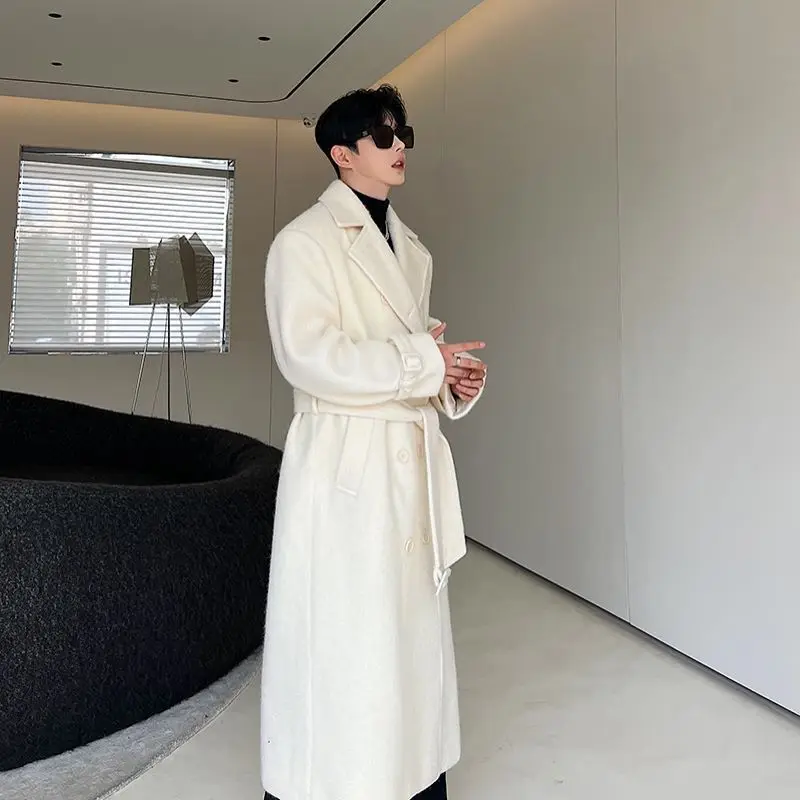
For optimal proportion, the perfect coat length for your height should generally follow these guidelines:
– 5‘8” and under: Mid-thigh to just above the knee
– 5‘9” to 6’: Knee-length
– Over 6’: Knee to mid-calf
Sleeve length should allow approximately ½ inch of your suit jacket sleeve to show, which typically means ending at the base of your thumb when arms are relaxed at your sides.
Identifying and Avoiding Common Fit Problems
Being aware of common fit issues can help you avoid costly mistakes when selecting your cashmere overcoat:
Button strain: Visible horizontal pulling around the closure indicates the coat is too tight. You should be able to button the coat comfortably without tension lines forming.
Shoulder divots: Indentations or creasing at the shoulder seam suggest the shoulders are too narrow or wide. The seam should follow your natural shoulder line smoothly.
Collar gaps: When buttoned, the collar should rest against your neck without standing away. Gaps indicate a fit issue in the chest or upper back.
Limited mobility: Test movement by reaching forward and crossing your arms. Severe restriction suggests the coat is too tight across the back or chest.
Sleeve pitch problems: Diagonal wrinkles from the shoulder to the elbow indicate the sleeve is not aligned with your natural arm position.
Most length and sleeve alterations are relatively straightforward, while changes to the shoulders or significant adjustments to the body are complex and costly. When considering longer overcoat styles, proper fit becomes even more critical to maintain a balanced silhouette.
Style Selection: Choosing a Design That Stands the Test of Time
Classic Overcoat Styles and Their Characteristics
When investing in a cashmere overcoat, selecting a timeless style ensures your purchase remains relevant for decades. Several classic designs have proven their staying power:
Single-breasted overcoats feature a clean front with a row of three to five buttons, offering versatility that transitions seamlessly between formal and casual settings. Their streamlined appearance flatters most body types and provides a contemporary aesthetic that works well in various professional environments.
Double-breasted models make a more authoritative statement with their overlapping front panels secured by two parallel rows of buttons. This design provides extra chest coverage for enhanced warmth and creates a more formal, distinguished appearance. Double-breasted coats particularly complement taller frames but can be adapted to various body types when properly proportioned.
The construction of the shoulders significantly impacts both comfort and style. Raglan sleeves extend in one piece from the collar to the underarm, creating a relaxed shoulder line that accommodates layers easily and suits casual settings. Set-in sleeves, attached at the natural shoulder line, provide a more defined, structured appearance appropriate for formal occasions.
Collar variations further define an overcoat’s character. Notch lapels offer versatile, understated elegance suitable for daily wear. Peak lapels create a more dramatic, formal effect that draws the eye upward and outward. Ulster collars, which can be turned up and buttoned across the neck, provide superior weather protection with a rugged, heritage appeal.
For a comprehensive overview of available options, explore our guide to men’s cashmere overcoat styles before making your selection.
Selecting the Perfect Color for Versatility
Color selection significantly impacts your overcoat’s versatility and longevity. Classic neutrals remain the most practical investment options:
Navy blue offers exceptional versatility, complementing virtually any outfit from formal business attire to casual weekend wear. Its deep tone hides minor soiling and works beautifully across seasons.
Charcoal gray provides similar versatility with a slightly softer appearance that pairs particularly well with blue suits and brown accessories. This urbane choice transitions seamlessly from boardroom to social occasions.
Camel represents a bold yet classic choice that makes a sophisticated statement. This warm neutral works beautifully with both formal and casual attire, though it shows wear and soiling more readily than darker options.
Black delivers formal elegance ideal for evening events and professional settings, creating a sharp, authoritative presence. Our black overcoat collection offers several refined options in this timeless shade.
When selecting a color, consider both your existing wardrobe and lifestyle needs. The ideal choice complements your typical attire while aligning with your regular activities – whether predominantly formal business settings or more varied casual environments.
Details That Add Distinction to Your Overcoat
The subtle details of your cashmere overcoat significantly impact its character and functionality:
Fabric patterns offer visual interest while maintaining sophistication. Herringbone provides classic texture that disguises minor wear and adds depth without overwhelming your outfit. Bird’s eye and other subtle patterns create visual dimension while remaining versatile. Explore our herringbone coat options for elegant patterned choices.
Button selection affects both appearance and durability. Horn buttons offer natural luxury with unique variations in color and pattern. Corozo (derived from nuts) provides an eco-friendly alternative with excellent durability. Covered buttons create a sleek, minimalist appearance ideal for formal overcoats.
Pocket styles balance aesthetics and functionality. Flap pockets provide security while maintaining a tailored appearance. Jetted pockets (with a nearly invisible slit opening) offer the cleanest, most formal look. Patch pockets add a casual, heritage touch while providing ample storage.
Interior features like full silk linings enhance comfort and ease of wear, while thoughtful details such as ticket pockets or inside breast pockets improve functionality without compromising the coat’s clean lines.
Construction Quality: What Sets Premium Overcoats Apart
Evaluating Fabric and Craftsmanship
Superior construction distinguishes an exceptional cashmere overcoat from merely adequate options. When examining potential purchases, assess these key indicators of quality:
Weave density directly affects warmth, durability and drape. Premium overcoats feature a tight, consistent weave that feels substantial without excessive weight. Hold the fabric up to light – quality cashmere allows minimal light penetration while maintaining softness and flexibility.
Seam construction reveals much about overall garment quality. Look for tight, even stitching with at least 10-12 stitches per inch. Premium coats often feature subtle pick stitching – a delicate, slightly visible hand-stitch along lapels and pockets that indicates meticulous craftsmanship. Pattern matching at seams, particularly visible on patterned fabrics, demonstrates attention to detail in the cutting and assembly process.
Button attachment methods matter for long-term durability. Quality overcoats secure buttons with a sturdy shank and reinforced backing, often using a traditional crow’s foot stitch pattern for both strength and decorative effect.
The internal structure profoundly affects how an overcoat drapes and retains its shape. Premium options typically feature canvas construction in the chest and lapels rather than fusible interfacing. Canvas molds to your body over time, creating a personalized fit that improves with wear, while maintaining the coat’s structural integrity.
For comparison, our wool overcoat collection demonstrates many of these same quality construction principles at different price points.
The Importance of Quality Lining and Interior Construction
The hidden interior elements of your cashmere overcoat contribute significantly to both comfort and longevity:
Quality linings enhance wearability while protecting the delicate cashmere fibers. Silk linings offer breathable luxury with a smooth feel that facilitates easy on-off movement. Cupro (Bemberg) provides silk-like performance with enhanced durability and temperature regulation. Viscose offers an economical alternative with good breathability, though typically with shorter lifespan than premium options.

Full linings extend from collar to hem, providing maximum protection for the cashmere and a smoother drape. Partial linings (typically in the upper back and sleeves) reduce weight and increase breathability but offer less protection for the fabric.
Interior pocket construction should match the coat’s overall quality with reinforced edges and secure closures. Well-designed coats include thoughtfully placed pockets at convenient heights – typically a breast pocket for valuables and lower pockets for larger items.
Seam finishing separates premium garments from mass-produced alternatives. Look for fully taped or bound seams that enhance comfort while preventing fraying. Premium overcoats often feature piped seam edges, creating a refined finish that indicates attention to invisible details.
Understanding these construction elements will help you style your cashmere overcoat confidently, knowing you’re showcasing quality craftsmanship.
Caring for Your Investment: Maintenance to Ensure Decades of Wear
Cleaning and Storage Best Practices
Proper care significantly extends the life of your cashmere overcoat, protecting your investment for years to come:
Professional dry cleaning should be limited to once or twice per season, as excessive cleaning can damage delicate fibers. Select cleaners with experience handling luxury fabrics and specify that your garment contains cashmere. Always clean your coat before seasonal storage to prevent moth damage from lingering food particles or body oils.
For minor refreshing between cleanings, hang your coat in a steamy bathroom to release wrinkles and odors naturally. Spot cleaning can address small stains – blot (don’t rub) with a clean, damp cloth and mild soap if necessary, then air dry completely.
Proper hanging is essential for maintaining your coat’s shape. Use wide, contoured wooden hangers that support the shoulders without stretching them. Allow adequate space in your closet for the garment to breathe rather than compressing it between other items.
Seasonal storage requires special attention. After cleaning, store your coat in a breathable garment bag (avoid plastic) in a cool, dry location away from direct sunlight. Cedar blocks or lavender sachets serve as natural moth deterrents without the harsh chemicals of mothballs. For comprehensive guidance on maintaining your timeless cashmere investment, proper storage is as important as cleaning.
Addressing Common Cashmere Issues
Even with careful maintenance, cashmere overcoats may develop certain issues over time that require attention:
Pilling – those small balls of fiber that can form on the surface – is natural with cashmere but should be addressed promptly. Use a specialized cashmere comb or fabric shaver, gently passing over affected areas with light pressure. Regular removal of pills prevents them from becoming more noticeable or pulling additional fibers.
Minor repairs deserve immediate attention before they worsen. Loose buttons should be resewn promptly with matching thread. Small tears or seam separations should be repaired by a professional tailor experienced with luxury fabrics.
To revive your coat’s appearance after extended wear, a gentle steaming can restore the nap and remove wrinkles without harsh pressing. Hang the coat in a bathroom during a hot shower or use a garment steamer held several inches from the fabric surface.
For serious issues like significant wear at cuffs or collars, professional reweaving or binding can extend your coat’s life considerably. These services are offered by specialized restoration experts who can often salvage garments that appear beyond repair.
For those who also own structured outerwear, our guide on double-breasted coat fit includes additional maintenance considerations that apply to both styles.
Mens Double Breasted Pea Coat, Mens Wool Blend Coat, Mens Wool Pea Coat
Price range: $136.84 through $157.36 Select options This product has multiple variants. The options may be chosen on the product pageMens Cashmere Overcoat, Mens Hooded Winter Coat, Mens Wool Blend Coat
Price range: $128.72 through $139.68 Select options This product has multiple variants. The options may be chosen on the product pageMens Black Overcoat, Mens Black Wool Coat, Mens Wool Overcoat
$339.18 Select options This product has multiple variants. The options may be chosen on the product pageMens Grey Overcoat, Mens Wool Blend Coat, Mens Wool Overcoat
$201.28 Select options This product has multiple variants. The options may be chosen on the product pageMens Herringbone Coat, Mens Long Overcoat, Mens Wool Overcoat
Price range: $197.16 through $203.69 Select options This product has multiple variants. The options may be chosen on the product pageMens Long Overcoat, Mens Topcoats
Price range: $189.40 through $196.88 Select options This product has multiple variants. The options may be chosen on the product page
Where to Find Quality Cashmere Overcoats
Finding exceptional cashmere overcoats requires knowing where to look and what to ask:
Traditional menswear retailers and high-end department stores offer the advantage of in-person assessment before purchase. These environments allow you to physically examine fabric quality, try various sizes, and compare different models side-by-side. Experienced sales associates can often provide valuable insights about construction details and fit adjustments.
Premium outerwear specialists focus exclusively on coat construction, often offering superior attention to technical details and more comprehensive size ranges. These retailers typically employ staff with specialized knowledge about fabric performance and construction techniques that affect longevity.
Made-to-measure and bespoke options provide the ultimate personalized experience, allowing customization of everything from shoulder construction to button selection. Though requiring a greater investment of both time and money, these services create truly individual garments tailored to your specific proportions and preferences.
Online retailers have expanded access to global brands and styles, often at competitive prices. When shopping remotely, look for detailed sizing guides, high-resolution images showing construction details, and liberal return policies that allow proper assessment at home. Before making online purchases, research fabric specifications thoroughly and don’t hesitate to contact customer service with specific questions about material composition or construction.
When speaking with sales associates, ask targeted questions that reveal their product knowledge: “What grade of cashmere is used in this coat?” “Is this fully canvassed or fused construction?” “Where was the fabric milled?” Knowledgeable responses indicate a retailer committed to quality offerings.
Understanding effective layering strategies will also help you select an overcoat with appropriate proportions for your typical wearing patterns.
Making the Final Decision: Your Pre-Purchase Checklist
Before making your final selection, use this comprehensive checklist to ensure your cashmere overcoat meets all critical criteria:
Quality Assessment:
– Confirm cashmere grade (Grade A preferred)
– Verify fiber length and micron count if available
– Check for dense, even weave without visible flaws
– Assess fabric hand (softness and drape)
– Examine seam construction and button attachment
– Verify full canvassing or quality chest piece
Fit Verification:
– Shoulders align with your natural shoulder edge
– Sleeves end at base of thumb/showing ½” of suit sleeve
– Comfortable closure without button strain
– Room for layering without excessive bulk
– Length proportionate to your height
– Collar sits flush against neck when buttoned
Style Evaluation:
– Classic design that complements your existing wardrobe
– Versatile color for multiple settings
– Details appropriate to your typical usage
– Balanced proportions for your body type
– Appropriate weight for your climate
Value Assessment:
– Calculate cost per wear (purchase price ÷ estimated wears per season × expected years of use)
– Compare quality/price ratio across several options
– Consider maintenance requirements and associated costs
For your final try-on, wear clothing similar to what you’ll typically layer underneath (e.g., a suit jacket or heavy sweater). Test movement by sitting, reaching forward, and crossing your arms. Take time to observe the coat from multiple angles in a full-length mirror.
Remember that a truly exceptional cashmere overcoat represents not just a purchase but an investment in your comfort and appearance for years to come. Our extensive overcoat collection offers numerous options that meet these quality benchmarks.
Is a Cashmere Overcoat Worth the Investment?
When considering the substantial investment a quality cashmere overcoat represents, it’s natural to question its value proposition. The answer depends largely on your lifestyle, climate, and personal priorities.
From a longevity perspective, a well-made cashmere overcoat typically serves its owner for 15-20 years or more with proper care – significantly outlasting synthetic alternatives or lower-quality wool coats. This exceptional lifespan dramatically improves the cost-per-wear calculation, often making premium cashmere more economical than repeatedly replacing inferior garments.
In practical terms, cashmere offers functional advantages that justify its price for many wearers. Its superior insulation properties provide exceptional warmth without bulk, making it ideal for professional settings where maintaining a sleek silhouette matters. The material’s natural temperature regulation prevents overheating when moving between outdoor cold and heated indoor environments – a significant advantage for active urban lifestyles.
For those in moderate climates with brief cold seasons, a cashmere-wool blend might represent a more practical option, offering many of cashmere’s benefits at a lower price point. However, in regions with extended, harsh winters, pure cashmere’s performance advantages become more valuable, justifying the additional investment.
Beyond practical considerations, many owners cite intangible benefits: the daily pleasure of wearing an exceptionally comfortable, beautiful garment; the confidence that comes from knowing you’re impeccably dressed; and the satisfaction of owning an item crafted with genuine artisanship. These factors, while difficult to quantify, contribute significantly to long-term satisfaction with your investment.

